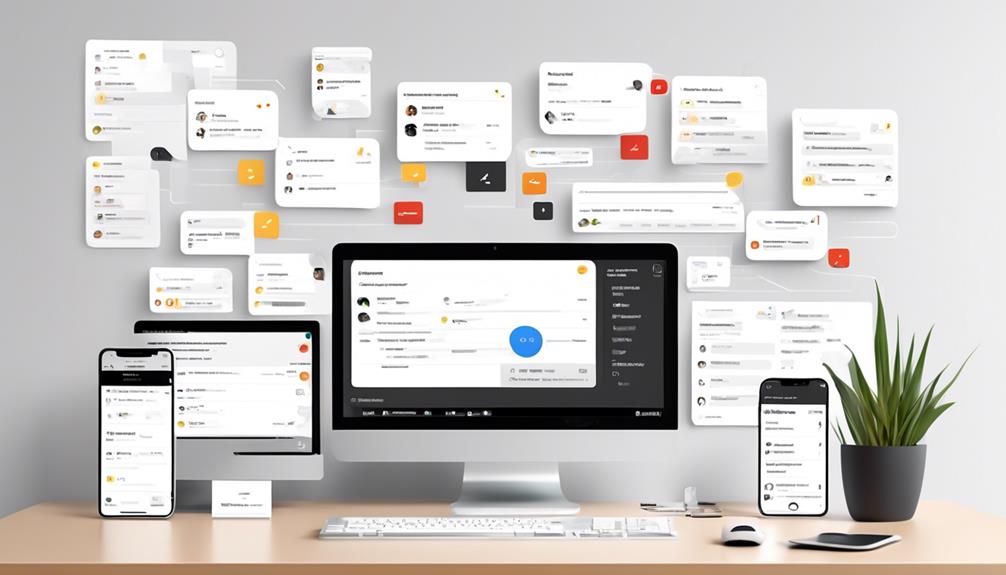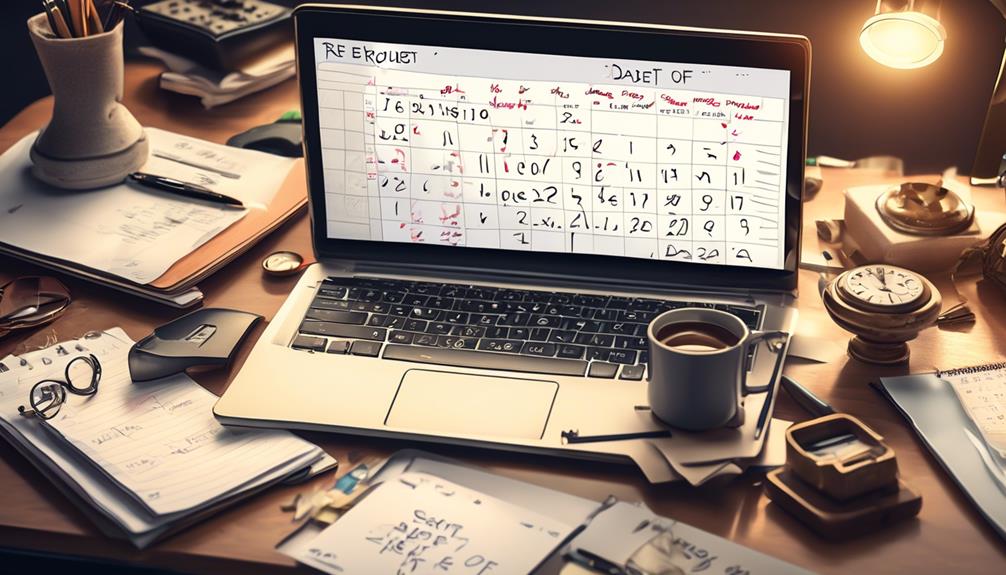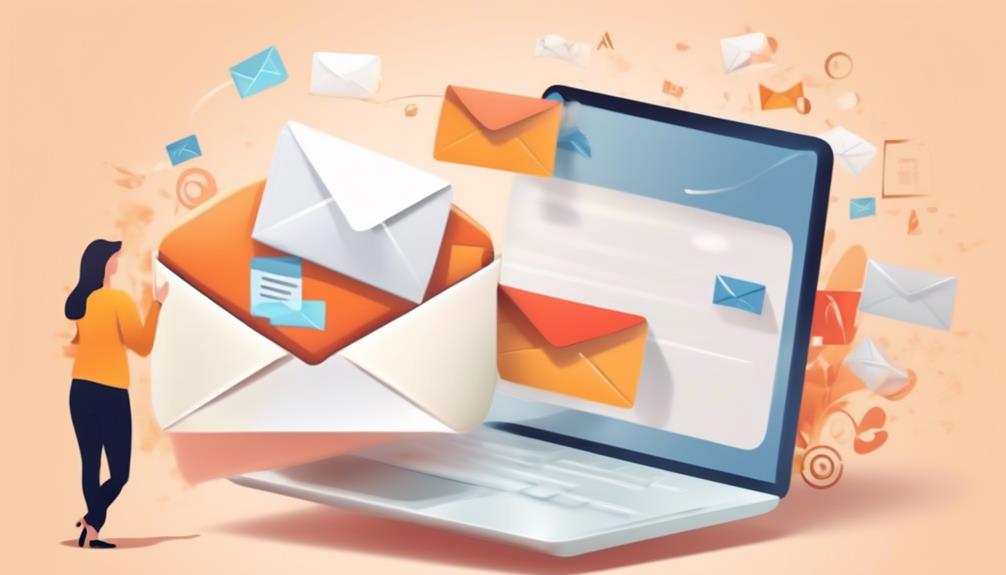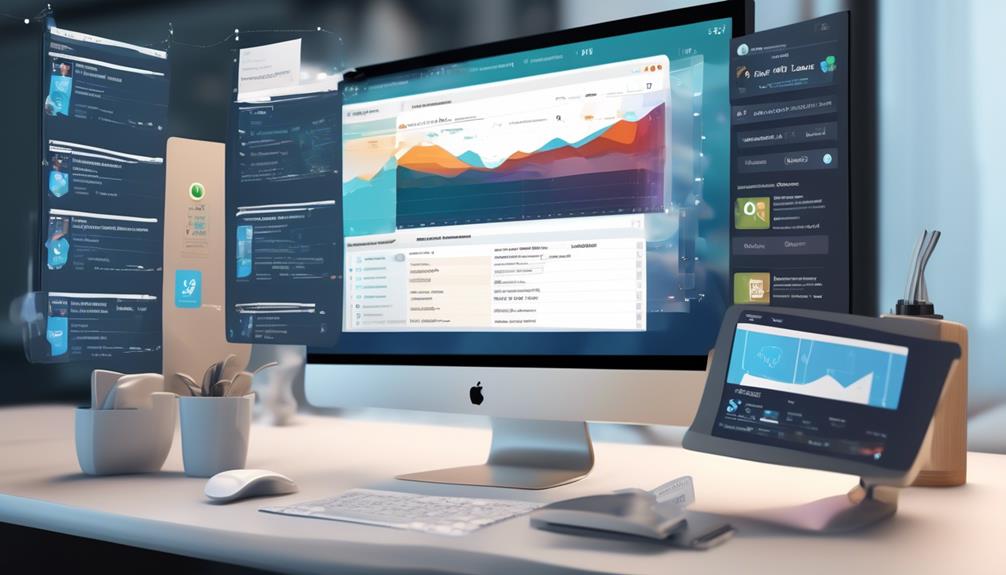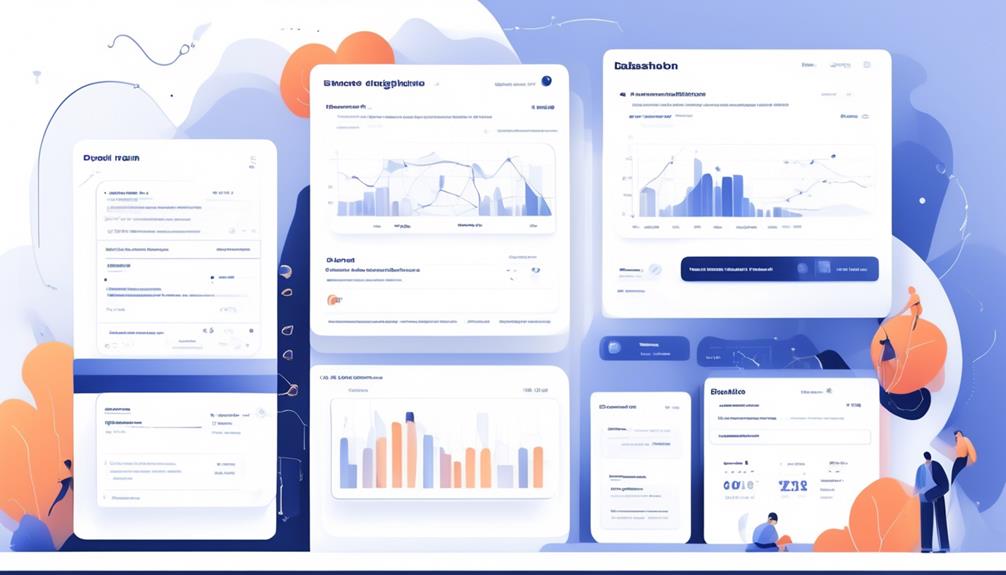In the realm of Jira, time equates to currency, and in matters of communication, being efficient is crucial. Jira Email Automation provides a sleek method to ensure all parties are informed without being overwhelmed by an excess of notifications.
But how exactly does it work, and what are the practical benefits of leveraging this automation? Let's explore how Jira Email Automation can revolutionize the way we handle communication and notification within our teams, making our workflow more seamless and our productivity soar.
Key Takeaways
- Jira Email Automation streamlines communication and notification processes in project lifecycle.
- Automation rules with JQL queries and triggers can efficiently send email notifications.
- Email automation saves time and improves task tracking by providing timely and personalized notifications.
- Configuring automation rules and customizing email notifications helps streamline communication within the team.
Understanding Jira Email Automation

We optionally employ Jira Email Automation to streamline communication and notification processes throughout the project lifecycle. This involves utilizing the Scheduled trigger for the automation rule and configuring the schedule for daily or hourly checks using JQL query conditions.
Additionally, we can make use of filter subscription emails as an alternative solution, allowing us to set the frequency of emails for desired issues. To address the issue of multiple emails being sent to assigned persons, we consider filter subscription emails to ensure only one email is sent when required.
Implementing the Scheduled automation rule with JQL query action and combining it with the 'send mail' action allows us to send email notifications efficiently. Furthermore, configuring the automation rule involves identifying the specific status to monitor, setting the time threshold for status not being changed, and specifying recipients and email content.
Understanding Jira email automation requires a comprehensive grasp of these features and their application in managing communication and notifications within the Jira platform.
Benefits of Email Automation in Jira

We'll explore the benefits of email automation in Jira, focusing on how it saves time and improves task tracking.
By automating notifications based on triggers and JQL queries, teams can stay updated on critical developments without manual effort.
This feature enhances efficiency and ensures that important tasks are promptly addressed.
Time-Saving Notifications
Time-saving notifications in Jira are a valuable aspect of email automation, allowing for efficient and targeted communication of crucial information to designated recipients.
When setting up automation rules, the send email action can be configured to notify specific recipients about open issues due next week, eliminating the need for manual effort.
Additionally, utilizing JQL queries in automation rules enables efficient filtering and identification of relevant issues for notification, reducing the necessity for manual search and selection.
Furthermore, Project Level Email Notifications can be utilized to ensure that only one email is sent to assigned persons when required, preventing inbox clutter and confusion.
These features streamline the notification process, saving time and effort for Jira users.
Improved Task Tracking
How can improved task tracking through email automation in Jira benefit your team's efficiency and productivity?
With Jira Software, automation rules can be set up to send email notifications for next-gen projects, enhancing task tracking capabilities. By utilizing JQL queries and filter subscription emails, teams can efficiently monitor and manage specific issues while customizing the frequency of email alerts.
The automation rule to send email notifications based on specific conditions, such as identifying specific statuses and setting time thresholds, aids in streamlining task tracking. Additionally, personalized email notifications can be scheduled or triggered for assignees, providing detailed information about open issues due in the next week.
This precise approach to task tracking enhances visibility, accountability, and overall productivity within the team.
Setting Up Email Notifications in Jira
How can email notifications in Jira be configured to efficiently manage and streamline communication within the team?
Setting up email notifications in Jira is crucial for ensuring that team members are promptly informed about important updates. To achieve this, consider the following steps:
- Utilize Automation Rules: Use the Scheduled trigger to configure the automation rule for regular checks, such as daily or hourly, ensuring that notifications are timely and consistent.
- *Implement JQL Queries*: Incorporate JQL queries like 'not status changed after -48h' and 'created -48h' to filter out irrelevant updates and validate the query to match the required conditions.
- Consider Alternative Solutions: Explore filter subscription emails as a viable alternative for managing multiple notifications sent to assigned individuals, providing flexibility in managing email volume effectively.
Customizing Email Notifications in Jira

Customizing email notifications in Jira involves configuring automation rules and customizing email templates to ensure precise and targeted communication. To achieve this, we can utilize the Scheduled trigger for the automation rule and configure the schedule for daily or hourly checks with the JQL query 'not status changed after -48h' and 'and created -48h' to validate the query. Another option is to consider using filter subscription emails as an alternative solution, creating a JQL search to find the desired issues, saving the search as a filter, and subscribing to the filter with a set frequency of emails. Additionally, if multiple emails are being sent to assigned persons, consider filter subscription emails to ensure only one email is sent when required.
To send an email, use the Scheduled automation rule with a JQL query action, in combination with the 'send mail' action to send email notifications. Furthermore, customizing the email template involves defining the conditions that trigger the automation rule, specifying the recipient(s) of the email notification, and regularly reviewing and updating the automation rule as needed.
| Automation Rule | Email Template | Recipient(s) |
|---|---|---|
| Scheduled trigger with JQL query action | Customized content and formatting | Registered user or Jira Service Desk agent |
Automated Email Notifications for Issue Updates

We will now cover the essential points of triggering email notifications, customizing email content, and managing recipient preferences.
By configuring the scheduled trigger for the automation rule, we can ensure timely issue updates notifications.
Utilizing JQL queries and filter subscription emails as part of the automation process will enhance the customization and management of email notifications for issue updates.
Triggering Email Notifications
To automate email notifications for issue updates, the Scheduled trigger can be utilized with a configured schedule for daily or hourly checks. This method ensures timely notifications for any updates.
To further refine the trigger, consider using the JQL query 'not status changed after -48h' and 'created -48h' to filter issue updates and ensure the query matches the condition.
Additionally, using filter subscription emails can be an alternative solution for managing multiple email issues efficiently. Employ the Scheduled automation rule with JQL query action and 'send mail' action to trigger email notifications for issue updates.
It's crucial to configure and test the automation rule, specify recipients, define content, and validate trigger conditions for effective email notifications.
These steps will streamline the process of triggering email notifications, enhancing communication and workflow in Jira.
Customizing Email Content
When customizing the email content for automated email notifications regarding issue updates, consider employing a well-structured template that accurately conveys relevant information to recipients. Utilize the customizable fields within Jira's email automation to tailor the content to the specific needs of the recipients.
This may include dynamically populating fields with issue details, such as summary, description, status, or assignee. Additionally, consider incorporating contextual information, such as the issue's history or related comments, to provide comprehensive updates to the recipients.
Ensure that the email content is clear, concise, and actionable, enabling recipients to understand the issue's current state and any necessary actions. By customizing the email content effectively, recipients can stay informed and engaged with the relevant issue updates, improving overall communication and collaboration within the team.
Managing Recipient Preferences
In customizing the email content for automated email notifications regarding issue updates, it's essential to manage recipient preferences effectively for delivering relevant and timely information.
When managing recipient preferences for Jira email automation, it's important to:
- Collect accurate email addresses from recipients to ensure notifications reach the intended individuals.
- Regularly verify and update recipient email addresses to maintain communication efficiency.
Streamlining Workflows With Email Automation

By employing the Scheduled trigger with a configured schedule and a JQL query, we can effectively streamline workflows through email automation in Jira. This allows for the automation of specific actions based on predefined schedules and JQL queries, ensuring that tasks are completed promptly and efficiently. Utilizing the Scheduled trigger enables regular checks, such as daily or hourly, to be performed, enhancing the overall efficiency of the workflow.
In addition to the Scheduled trigger, the use of filter subscription emails provides an alternative solution for managing multiple emails being sent to assigned persons. This ensures that individuals receive relevant and timely information without being inundated with unnecessary emails.
Email Automation Best Practices

We recommend implementing email automation best practices to maximize efficiency and streamline communication within the Jira system. When setting up email automation in Jira, it's essential to follow best practices to ensure seamless functionality and effective communication.
Here are some best practices to consider:
- Scheduled Trigger Configuration
- Use the Scheduled trigger for automation rules and configure the schedule for daily or hourly checks.
- Set up filter subscription emails as an alternative solution and define the frequency of emails.
- Avoiding Overwhelming Recipients
- Address the issue of multiple emails being sent to assigned persons by considering filter subscription emails.
- Utilize the JQL query action in the Scheduled automation rule to send targeted email notifications based on specific criteria.
Utilizing Jira Email Automation for Productivity

Utilizing Jira Email Automation for enhanced productivity can significantly streamline communication and facilitate efficient task management within the system.
By leveraging the Scheduled trigger for automation rules, users can configure daily or hourly checks with specific JQL queries such as 'not status changed after -48h' and 'created -48h' to validate the query.
Another productive approach involves utilizing filter subscription emails, where a JQL search is created to find desired issues, saved as a filter, and then subscribed to with a set frequency. This method helps in reducing the number of emails sent to assigned persons by ensuring that only one email is sent when required.
Additionally, the Scheduled automation rule with JQL query action, combined with the 'send mail' action, can be used to send email notifications, further enhancing productivity.
When setting up and configuring the automation rule, it's crucial to identify specific statuses to monitor, set time thresholds, determine actions to be taken, configure the rule, specify recipients and email content, and regularly review and update the rule as needed to maintain productivity within the Jira system.
Enhancing Team Communication With Email Automation

Let's explore how Jira email automation can streamline team updates and improve task notifications.
By using scheduled triggers and JQL queries, we can automate the process of checking for specific conditions on a daily or hourly basis, ensuring that everyone stays informed.
Additionally, filter subscription emails offer a convenient alternative for managing email notifications, allowing for better control over the flow of information to assigned persons.
Streamlining Team Updates
To enhance team communication with email automation, consider configuring the Scheduled trigger for daily or hourly checks and utilize the JQL query 'not status changed after -48h' combined with 'and created -48h' for accurate issue selection.
When streamlining team updates, it's essential to:
- Set up filter subscription emails as an alternative to prevent multiple emails to assigned persons. This helps in controlling the flow of notifications and prevents overwhelming team members with redundant emails.
- Create an automation rule with a JQL query action combined with a 'send mail' action. This ensures that relevant team updates are automatically communicated via email, improving overall team communication and collaboration.
Improving Task Notifications
Improving task notifications through email automation can significantly enhance team communication and streamline workflow processes. By utilizing Jira's scheduled trigger for automation rules, we can enhance task notifications through regular, automated checks. Additionally, leveraging JQL queries such as 'not status changed after -48h' and 'and created -48h' can further refine task notification criteria. For managing multiple email issues, consider filter subscription emails as an alternative solution. To implement these improvements, configure the automation rule in the system, specifying recipient(s), content, format, and trigger conditions. Furthermore, setting up an SMTP mail server, customizing email content, and configuring notification schemes can enhance email notifications in Jira. Below is a table summarizing key aspects of improving task notifications through email automation.
| Aspect | Description | Example |
|---|---|---|
| Scheduled Trigger | Automation rule trigger for regular checks | Daily or hourly checks |
| JQL Queries | Criteria for refining task notifications | 'not status changed after -48h', 'and created -48h' |
| Filter Subscription Emails | Alternative solution for managing multiple email issues | Managing multiple issues |
Integrating Jira Email Automation

Integrating Jira Email Automation can streamline communication and enhance workflow efficiency for managing tasks and notifications within the Jira platform. When integrating Jira Email Automation, it's essential to consider the following points:
- Use the Scheduled trigger for the automation rule and configure the schedule for daily or hourly checks, along with a JQL query like 'not status changed after -48h' and 'and created -48h'. This ensures that the automation rule runs at specific intervals to send timely email notifications based on the defined JQL query.
- Consider filter subscription emails as an alternative solution to prevent multiple emails being sent to assigned persons and ensure only one email is sent when required. This prevents email overload for the recipient and ensures that relevant information is effectively communicated.
Troubleshooting Email Automation in Jira

When troubleshooting email automation in Jira, we can address any issues that may arise from the integration of Jira Email Automation by:
- Validating the Scheduled trigger and JQL query.
- Considering alternative solutions, such as filter subscription emails, to optimize the notification process.
It's essential to configure the Scheduled trigger and set up the schedule for regular checks, whether daily or hourly, to ensure timely notifications. Additionally, adding specific conditions like 'not status changed after -48h' and 'created -48h' to the JQL query is crucial. Validating the JQL query ensures that it accurately matches the intended conditions for triggering email notifications.
In cases where multiple emails are being sent to assigned persons, considering filter subscription emails as an alternative solution can streamline the notification process. Utilizing the Scheduled automation rule with JQL query action and combining it with the 'send mail' action provides a comprehensive approach to sending email notifications.
When troubleshooting email automation in Jira, configuring the automation rule, testing its functionality, and specifying recipients, content, format, and any additional settings for the email notification are essential for efficient troubleshooting and resolution of any issues.
Advanced Email Automation Techniques

We can enhance email automation in Jira by leveraging advanced techniques such as incorporating dynamic JQL queries and refining trigger conditions for targeted and efficient notifications. To achieve this, we can:
- Utilize scheduled triggers: Set up automation rules to run at specific times, ensuring regular checks and timely notifications.
- Configure precise JQL queries: Incorporate specific conditions such as 'not status changed after -48h' and 'created -48h' to ensure the execution of rules with accuracy and relevance.
- Consider filter subscription emails: Use this alternative solution to customize and manage email notifications effectively.
Jira Email Automation for Team Collaboration

To optimize team collaboration in Jira through email automation, consider leveraging the scheduled trigger for timely notifications and configuring filter subscription emails to avoid multiple notifications to assigned individuals. By using the scheduled trigger, we can automate the process of sending notifications at specific times, enhancing team collaboration. Additionally, filter subscription emails provide an alternative solution, allowing us to set the frequency of emails and avoid inundating team members with multiple notifications.
| Automation Technique | Description |
|---|---|
| Scheduled Trigger | Automate timely notifications using JQL queries such as 'not status changed after -48h' and 'created -48h'. |
| Filter Subscription Emails | Set the frequency of emails by creating a JQL search, saving it as a filter, and subscribing to it to avoid multiple notifications. |
Managing Email Rules in Jira

When managing email rules in Jira, it's essential to focus on email rule setup and adhere to automation best practices.
We'll explore the setup process for email rules and discuss best practices to ensure efficient and effective automation.
Understanding the key points of email rule management will contribute to streamlining communication and improving workflow within Jira.
Email Rule Setup
Utilize the Scheduled trigger for the automation rule and configure the schedule for daily or hourly checks to manage email rules in Jira effectively.
To set up email rules:
- Use the JQL query 'not status changed after -48h' and add 'and created -48h' to the JQL query. This ensures that the email rule captures issues where the status hasn't changed for 48 hours and were created 48 hours ago.
- Consider filter subscription emails as an alternative solution and create a JQL search to find the desired issues. This can be useful when multiple emails are being sent to assigned persons, ensuring only one email is sent when required.
Automation Best Practices
We frequently incorporate the scheduled trigger for automation rules to effectively manage email rules in Jira. By configuring the scheduled trigger for daily or hourly checks, we ensure that email notifications are sent promptly.
When setting up the automation rule, we employ the JQL query 'not status changed after -48h' and include 'and created -48h' to validate the conditions.
Additionally, we consider filter subscription emails as an alternative solution, adjusting the frequency after creating a JQL search and saving it as a filter.
For email notifications, the scheduled automation rule with JQL query action combined with the 'send mail' action proves to be beneficial.
It's essential to configure the automation rule by specifying the status to monitor, setting the time threshold for status not being changed, and defining recipients and email content to ensure effective email automation in Jira.
How Can Jira Email Automation Help with Creating Effective Email Subject Lines?
Jira automation email subject lines can help streamline the process of creating effective email subject lines by automatically analyzing data and suggesting personalized subject lines. This can save time for the marketing team and ensure that the subject lines are optimized for maximum open rates and engagement.
Implementing Email Automation for Efficiency

To enhance operational efficiency, consider incorporating the Scheduled trigger for automation and configuring daily or hourly checks to optimize the email automation process. This will ensure timely and precise delivery of automated emails, improving overall workflow efficiency.
When implementing email automation for efficiency, it's crucial to utilize JQL queries effectively. Some key considerations include using queries like 'not status changed after -48h' and 'created -48h' to filter and validate desired issue conditions. Additionally, using filter subscription emails as an alternative solution can help manage multiple email issues efficiently.
Another important aspect is to utilize the JQL query action in conjunction with the 'send mail' action for effective email automation.
Lastly, ensure thorough setup and configuration of automation rules, including defining trigger conditions, recipient details, and email content for efficient implementation.
Frequently Asked Questions
Can Jira Send Automated Emails?
Yes, we can send automated emails in Jira.
We set up scheduled triggers with specific JQL queries for daily or hourly checks.
Additionally, we can use filter subscription emails by creating a JQL search, saving it as a filter, and subscribing to it with the desired frequency.
To address multiple emails being sent to assigned persons, we consider using filter subscription emails to ensure only one email is sent when required.
Can We Trigger Email From Jira?
Yes, we can trigger email notifications from Jira.
Utilizing the Scheduled trigger and JQL query, we can automate email notifications based on specific conditions.
Additionally, filter subscription emails can be used to manage and avoid multiple notifications being sent to assigned persons.
Thorough setup and configuration of the automation rule in Jira is essential to ensure successful triggering and sending of email notifications as intended.
Can You Email Tasks From Jira?
Yes, we can email tasks from Jira by setting up automation rules to send email notifications based on specific triggers or conditions.
This allows us to keep stakeholders informed about task updates and changes without manual intervention.
The automation rules can be configured to send emails to designated recipients when certain criteria are met, ensuring efficient communication and task management within the Jira platform.
Can Jira Integrate With Email?
Yes, Jira can integrate with email through scheduled triggers for automation rules and filter subscription emails.
This allows users to subscribe to a filter and set the frequency of emails.
By using the JQL query action in a scheduled automation rule, Jira can be integrated with email, sending notifications through the 'send mail' action.
This process involves identifying specific status, setting time thresholds, determining actions, and configuring the rule in the system.
Conclusion
In conclusion, Jira Email Automation offers a seamless and efficient way to flood your inbox with notifications and updates.
It allows for constant communication and ensures that no one is ever out of the loop, whether they like it or not.
With the ability to customize and set up rules, Jira Email Automation is the perfect tool for inundating your team with emails for maximum efficiency.

